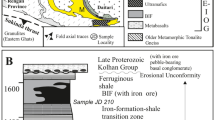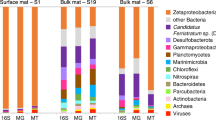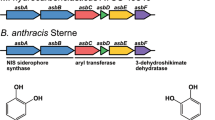Abstract
CONCLUSIVE evidence for microbial participation in the genesis of the massive sedimentary iron formations from the Precambrian is fragmentary. Structures resembling fossilised bacteria have been reported previously, and they tend to resemble modern iron bacteria such as Sphaerotilus, Gallionella and Metallogenium1,2. The atmosphere at that time is believed to have been almost devoid of oxygen3. The concentration of atmospheric oxygen probably ranged from 0.0001 to 0.001% of the present atmospheric level, and may have remained at this level for 2 × 109 yr after the emergence of algal photosynthesis4. The fossils described in this paper were found during a study of the mineralogy of the Lower Proterozoic Brockman Iron Formation (Hamersley Group) of Western Australia (about 2 × 109yr old5). Two specimens (PM9 and PM24) collected from the Whaleback Shale Member, at Wittenoom Gorge, were identified as dolomitic chert by X-ray diffraction. Optical microscopy showed the presence of fibrous stilpnomelane, and the staining technique suggested by Dickson6 distinguished the dolomite as ferroan.
This is a preview of subscription content, access via your institution
Access options
Subscribe to this journal
Receive 51 print issues and online access
$199.00 per year
only $3.90 per issue
Buy this article
- Purchase on SpringerLink
- Instant access to full article PDF
Prices may be subject to local taxes which are calculated during checkout
Similar content being viewed by others
References
Cloud, P. E., Jr, Science, 148, 27–35 (1965).
Tyler, S. A., and Barghoorn, E. S., Science, 119, 606–608 (1954).
Cloud, P. E., Jr, Evolution and Environment (edit. by Drake, T.), 72 (Yale University Press, 1968).
Berkner, L. V., and Marshall, L. C., Proc. natn. Acad. Sci. U.S.A., 33, 1215–1225 (1965).
Compston, W., and Arriens, P. A., Can. J. Earth Sci., 5, 561–583 (1968).
Dickson, J. A. D., Nature, 205, 587 (1965).
Schopf, J. M., Rev. Palaeobotan. Palynol., 20, 27–53 (1975).
Muir, M. D., Hamilton, L. H., Grant, P. R., and Spicer, R. A., in Microprobe Analysis as Applied to Cells and Tissues (edit. by Hall, T., Echlin, P., and Kauimann, R.), 33–58 (Academic, London and New York, 1974).
Barghoorn, E. S., and Tyler, S. A., Science, 147, 563–575 (1965).
Walter, M. R., Abstr. First Australian Geol. Convention, Proterozoic Geology, Adelaide, 15–16 (1975).
Broed, R. S., in Bergey's Manual of Determinative Bacteriology, 4–14 (Williams and Wilkins, Baltimore, 1975).
Author information
Authors and Affiliations
Rights and permissions
About this article
Cite this article
KARKHANIS, S. Fossil iron bacteria may be preserved in Precambrian ferroan carbonate. Nature 261, 406–407 (1976). https://doi.org/10.1038/261406a0
Received:
Accepted:
Issue date:
DOI: https://doi.org/10.1038/261406a0
This article is cited by
-
Ancient microbe database
Nature (1992)
-
Early geological record and the origin of life
Naturwissenschaften (1984)



